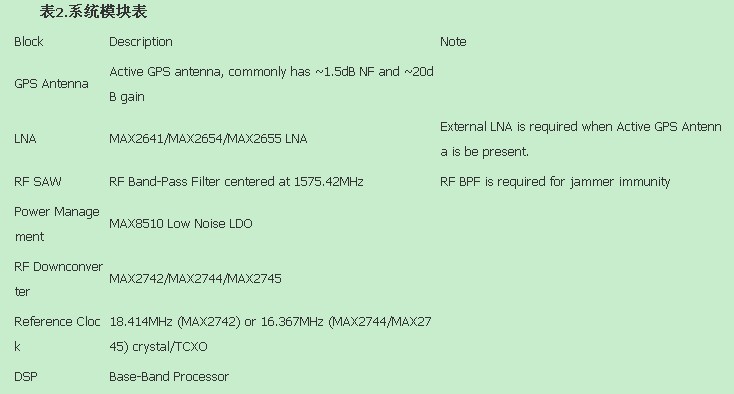Part 1: GPS Overview
This article refers to the address: http://
The Global Positioning System (GPS) consists of 24 communication satellites distributed in six orbits. These satellites orbit the Earth twice a day, and the angle of inclination relative to the equator is about 55 degrees. These 24 satellites continuously transmit coded positioning and timing information at high frequencies (1500 MHz range).
The GPS ground receiver receives the signal and uses the encoded information to calculate the position of the Earth coordinate system. The receiver determines the position by calculating the time at which the wireless signal transmitted from each satellite arrives at the receiver. Multiply the time by the speed of light to get the distance from the receiver to each satellite: distance = speed of light x time. The time can be obtained by the exact code matching technique in the GPS receiver. The position of each satellite is encoded in the transmitted signal. With these data, the receiver is able to perform three-dimensional coordinate calculations on the position on the Earth.
Differential GPS improves accuracy
Differential GPS, or DGPS, uses a high-performance GPS receiver (reference base station) at a known location, and GPS accuracy can be increased to a few meters. Since the reference base station knows its exact position, it is possible to determine the error information of the satellite signal. The error data for each tracking satellite is formatted into error correction information that is sent to each GPS user. These differential error correction information is then used for GPS calculations, eliminating most satellite error signals and improving accuracy.
GPS signals are globally available and can pinpoint any location on the planet. GPS products have been developed for many commercial applications. As technology continues to improve, the size and price of GPS receivers become very important.
Part II: Maxim Chip Solutions
The MAX2742/MAX2744/MAX2745 are high-performance CMOS monolithic GPS front-end downconverters. These current state-of-the-art devices consume ultra-low power and do not require expensive IF surface acoustic filters or bulky discrete mid-band pass filters. Each device integrates a low noise amplifier (LNA), mixer, bandpass filter (BPF), automatic gain control (AGC) amplifier and local oscillator synthesizer, clock buffer and digital sampler.
The MAX2742/MAX2744/MAX2745 can be used with many of today's commercial GPS baseband chips, such as in-vehicle guidance systems, in-vehicle information services systems, automated security systems, asset tracking, location-based services (LBS) and baseband chips for consumer electronics applications. These devices require a complete external circuit to provide a complete GPS RF solution. The system block diagram is given in the next section.
The MAX2742 operates at 18.414MHz (18 x 1.023MHz, one tenth of the GPS baseband 10.23MHz) crystal or a temperature-compensated crystal oscillator (TCXO), providing a differential or single-ended IF 1.023MHz output. The MAX2744 operates from a 16.367MHz (16 x 10.23MHz) crystal or a temperature-compensated crystal or a 32.736MHz crystal or a temperature-compensated crystal. It provides a differential or single-ended, digital IF output with a center frequency of 4.092MHz.
The MAX2745 is an improved version of the MAX2744 that provides additional features such as voltage boosters, temperature sensors, and VCO calibration capacitors.
Table 1 below gives a chip selection guide. For details, please refer to the MAX2742/4/5 data sheet and evaluation data sheet.

Complete GPS RF front-end solution
The block diagram below shows the main components and Maxim's complete GPS RF solution. Table 2 gives a description of the component modules, and Table 3 gives the performance of the cascade.


Part III: Maxim GPS Receiver Module
Maxim offers cost-effective, high-performance GPS receiver modules. The following modules use the MAX2742 RF downconverter and the Sony CXD2932 baseband chip. This two-chip configuration system is capable of measuring any location on the planet and demonstrates a small, lightweight solution.

figure 1.
The MAX2742's complete single-chip Global Positioning System (GPS) RF front end uses many innovative RF CMOS design techniques. This high-performance, state-of-the-art device consumes very little power and eliminates the need for costly SAW filters and bulky discrete clock filters. The MAX2742 consists of a fully integrated low noise amplifier (LNA), IF section, digital sampler, and local oscillator synthesizer. The MAX2742 input signal is 1.57542GHz. L1 GPS signal. This device supports high-precision output quantization and provides the best performance for GPS receivers.

This Maxim GPS receiver module has the following advantages:
16-channel GPS receiver capable of receiving 16 satellite signals simultaneously
All-view or two-star measurement
DGPS (Differential GPS): Support
RTCM SC104 version 2.1
DARC BTA R-003
Power management function
Lightweight package: 1024milX1024mil
We offer rechargeable li ion and Lipo Battery cells from industry's leading manufacturers, Panasonic cells, Sanyo cells, Moli cell, ATL cells, BAK cells, DLG cells, HYB cells, Samsung cells, LG cells, Maxell Cells. With contacts inside big manufacturers, we are able to supply authentic cells in wide variations of sizes, capacities, and power performances to meet your needs. In addtion we provide processing service to add proteced PCB in cell, to put heat shrink tubes, wires with designated connector, or to design unique plastic case with coaxial DC port.

Rechargeable Batteries,Rechargeable Lithium Batteries,Rechargeable Cell,Lithium Ion Rechargeable Batteries
Asarke Industry Co., Limited , https://www.asarke-industry.com